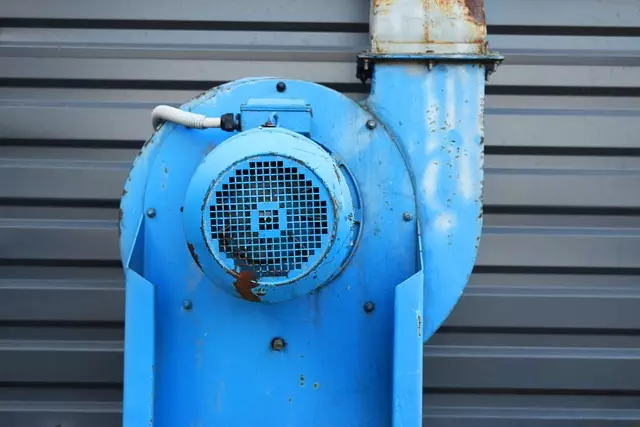Smoke testing is a vital method for evaluating industrial ventilation systems' performance and ensuring workplace air quality management. By releasing visible indicators like smoke or fluorescent dye, professionals can detect leaks, blockages, or deficiencies in ventilation systems, adhering to strict ventilation safety standards. This non-invasive technique identifies hazards like toxic gas accumulation, enabling proactive maintenance. Effective workplace air quality management relies on optimal industrial ventilation systems, which control airborne contaminants and maintain fresh air flow. Compliance with ventilation safety standards prevents health issues, enhances productivity, and fosters a positive organizational culture. Smoke testing, using techniques like fluorescent smoke or pressure differential measurement, uncovers leaks in ventilation systems, ensuring compliance and worker safety. Regular inspections by skilled personnel with advanced equipment are key to a successful smoke testing program, integral to a robust workplace air quality management strategy.
Smoke testing methods are essential components of workplace safety, especially in industries with complex ventilation systems. This article delves into the intricacies of smoke testing, offering a comprehensive guide for professionals. We explore the role of industrial ventilation systems in maintaining safe work environments and the significance of workplace air quality management. Understanding ventilation safety standards is crucial for compliance and accident prevention. Through an in-depth look at various smoke testing methods, case studies, and practical implementation tips, this guide equips readers with knowledge to ensure workplace safety through effective testing programs.
- Understanding Smoke Testing: A Brief Overview
- Industrial Ventilation Systems and Their Role in Workplace Safety
- The Importance of Air Quality Management in Maintaining Safe Workplaces
- Ventilation Safety Standards: Legal Framework and Compliance
- Methods of Smoke Testing: An In-Depth Look
- Implementing Effective Smoke Testing Programs
- Case Studies: Successful Smoke Testing Applications
Understanding Smoke Testing: A Brief Overview
Smoke testing is a critical method employed to assess and ensure the effectiveness of industrial ventilation systems in maintaining workplace air quality management. This process involves the deliberate release of smoke or other visible indicators into an enclosed space to simulate real-world scenarios and identify potential issues with airflow and exhaust systems. By using smoke, professionals can visually detect leaks, blockages, or inadequacies in ventilation safety standards, ensuring a well-ventilated and safe working environment.
In the context of industrial settings, where workplace air quality is paramount, smoke testing plays a vital role. It helps identify hazards associated with poor ventilation, such as the accumulation of toxic gases or particulates. This non-invasive technique allows for proactive maintenance and adjustments to be made, aligning with industry best practices and regulatory guidelines for ventilation safety standards.
Industrial Ventilation Systems and Their Role in Workplace Safety
Industrial ventilation systems play a pivotal role in maintaining optimal workplace air quality and ensuring worker safety. These sophisticated mechanisms are designed to control, direct, and remove hazardous gases, fumes, dust, and other airborne contaminants from industrial settings. By implementing proper ventilation, workplaces can mitigate risks associated with poor air quality, such as respiratory issues, chemical exposures, and increased fire hazards.
Effective industrial ventilation systems adhere to stringent safety standards, ensuring a constant flow of fresh air while expelling pollutants. This is achieved through strategic placement of vents, fans, and ductwork, which facilitate the displacement of contaminated air and introduce clean, breathable air. Regular maintenance and adherence to best practices in ventilation design and operation are crucial for upholding workplace safety and promoting a healthy environment for employees.
The Importance of Air Quality Management in Maintaining Safe Workplaces
Maintaining safe workplaces is paramount, especially in industrial settings where air quality can significantly impact worker health and productivity. Effective workplace air quality management involves ensuring optimal industrial ventilation systems. These systems play a crucial role in controlling and managing airborne contaminants, ensuring a healthy working environment.
Adhering to strict ventilation safety standards is essential for preventing respiratory issues, reducing exposure to harmful substances, and fostering overall well-being among employees. Proper air quality management not only enhances worker safety but also contributes to improved productivity, reduced absenteeism, and a positive organizational culture.
Ventilation Safety Standards: Legal Framework and Compliance
In many industries, especially those involving hazardous materials or high-risk environments, adhering to ventilation safety standards is paramount for ensuring workplace air quality management. The legal framework surrounding industrial ventilation systems is designed to protect workers from respiratory hazards, including toxic gases, dusts, and other pollutants. Compliance with these regulations not only mitigates health risks but also prevents accidents and legal repercussions.
Governing bodies worldwide have established guidelines and standards for ventilation safety, which often require regular inspections, maintenance, and proper design of industrial ventilation systems. Employers are responsible for implementing effective strategies to control airborne contaminants, ensuring adequate exhaust and intake ventilation. By maintaining compliance with these standards, companies demonstrate their commitment to workplace safety and contribute to a healthier, safer environment for employees.
Methods of Smoke Testing: An In-Depth Look
Smoke testing is a critical component of workplace air quality management and industrial ventilation systems. This method involves releasing smoke or artificial smoke into a system to identify any leaks or gaps in the ventilation. By using this technique, professionals can ensure that the ventilation safety standards are met, maintaining a healthy work environment free from hazardous pollutants.
There are various methods employed in smoke testing, each with its advantages and applications. One common approach is the use of fluorescent smoke, which illuminates any imperfections in the system when excited by ultraviolet light. This method allows for quick identification of small cracks or seals that might be missed by other tests. Another technique involves pressure differential measurement, where changes in air pressure are monitored to detect leaks. This is particularly useful for complex industrial ventilation systems where traditional visual inspection may not suffice. These methods, integrated into a comprehensive workplace air quality management strategy, play a vital role in ensuring the safety and well-being of workers.
Implementing Effective Smoke Testing Programs
Implementing effective smoke testing programs is paramount for ensuring the integrity and safety of industrial ventilation systems. These rigorous tests play a pivotal role in workplace air quality management by identifying potential leaks or deficiencies in exhaust systems, which could lead to hazardous airborne contaminants. By adhering to established ventilation safety standards, companies can protect workers from inhaling toxic fumes and ensure compliance with regulatory requirements.
A comprehensive smoke testing program involves strategic planning, skilled personnel, and the use of advanced equipment. Regular inspections, coupled with meticulous record-keeping, are essential for identifying trends and pinpointing areas needing improvement. Integrating these practices into a robust workplace air quality management strategy fosters a culture of safety and helps maintain optimal working conditions.
Case Studies: Successful Smoke Testing Applications
Smoke testing has proven its value in various industries, demonstrating its effectiveness in ensuring workplace air quality management and adhering to ventilation safety standards. Case studies show that industrial ventilation systems benefit significantly from this method. For instance, in manufacturing plants, smoke testing helps identify leaks in exhaust systems, preventing hazardous fumes from escaping into the workplace. This application not only enhances ventilation safety but also improves overall worker comfort and health.
Another successful application is seen in office buildings where proper air circulation and filtration are essential for maintaining good indoor air quality. Smoke testing allows experts to assess the effectiveness of HVAC (Heating, Ventilation, and Air Conditioning) systems, ensuring they meet the required standards. By simulating various scenarios, such as increased occupancy or specific activities that generate airborne contaminants, smoke testing helps identify areas of improvement in ventilation design and maintenance routines.


